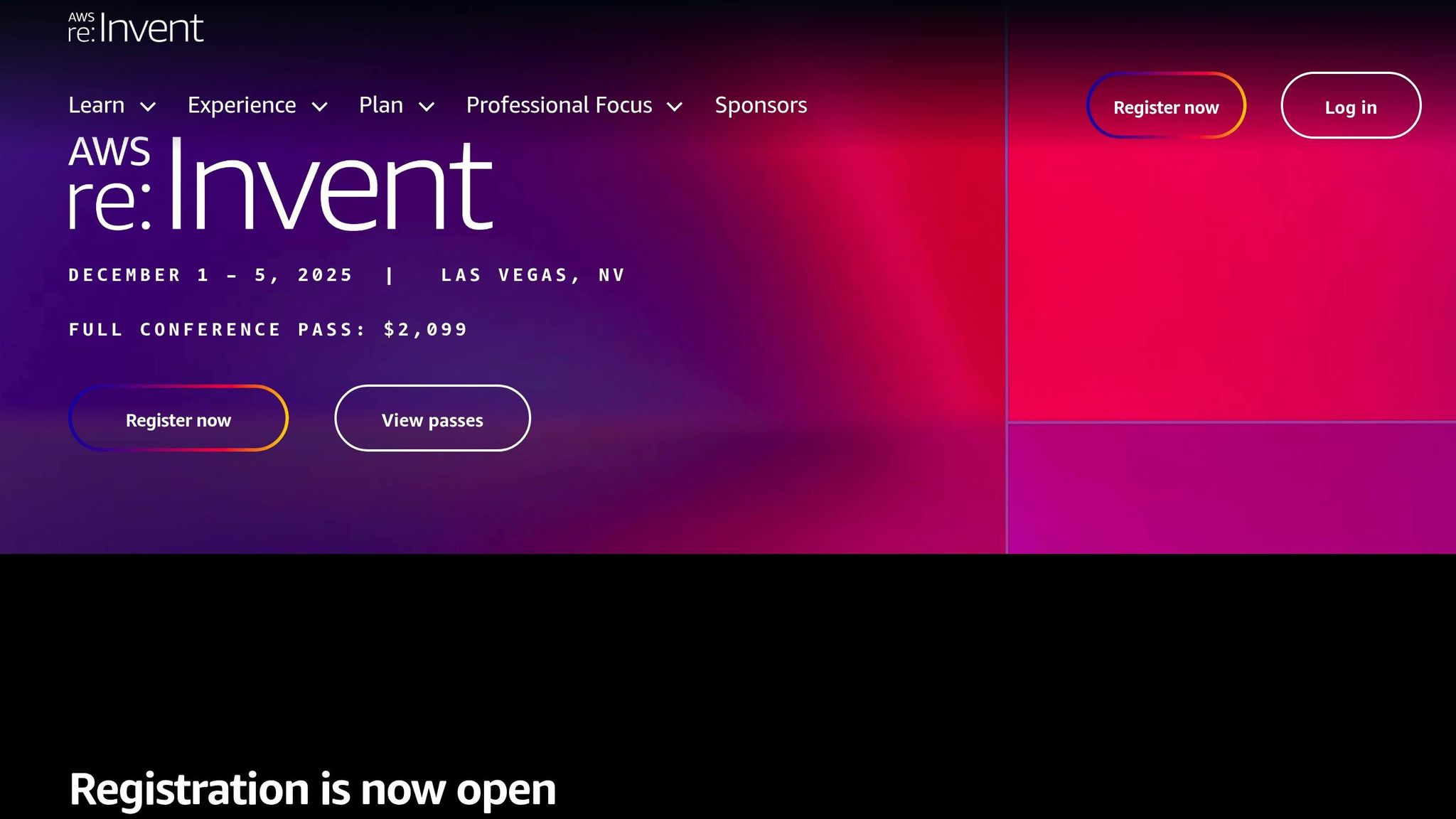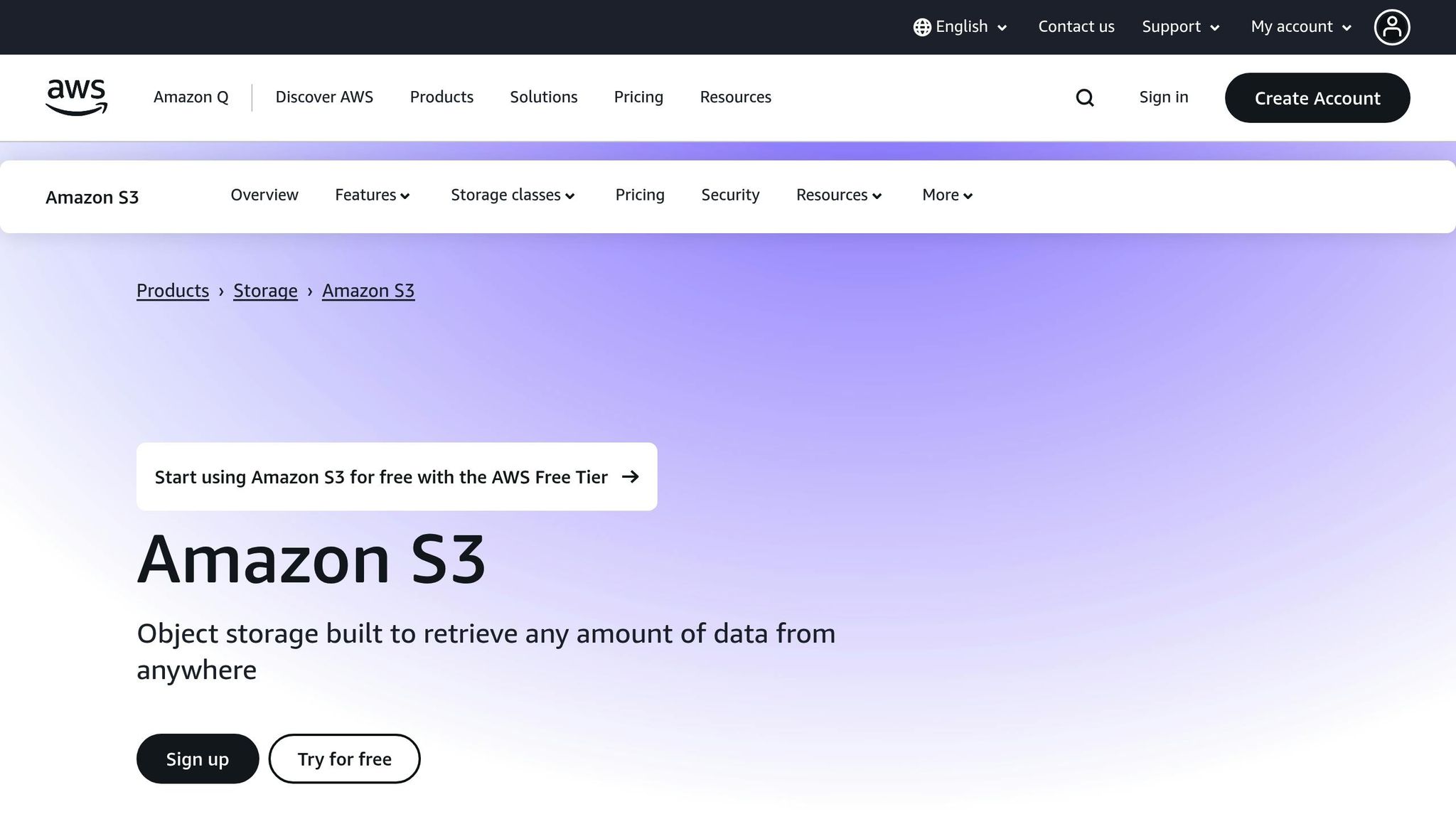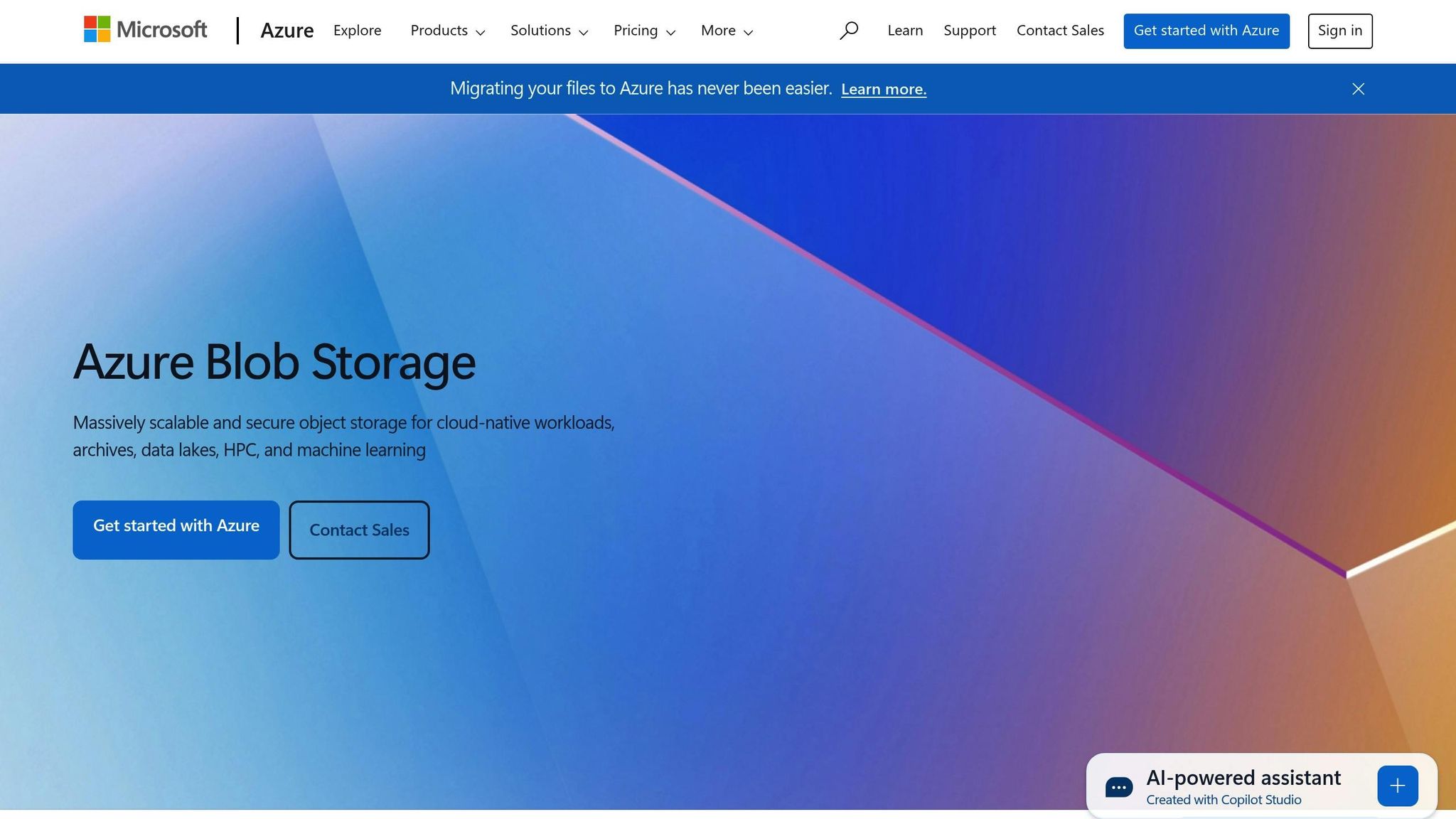UK businesses are facing rising cloud storage costs, with 47% of total cloud expenses tied to storage fees. To manage these costs without losing performance, many organisations are turning to platforms like Amazon S3, Azure Blob Storage, and Google Cloud Storage. Each offers cost-saving features, high durability, and compliance with UK-specific regulations like GDPR.
Key Takeaways:
- Amazon S3: Offers automated tiering with savings up to 95% (Deep Archive), excellent scalability, and high durability (99.999999999%). However, pricing complexity may challenge smaller businesses.
- Azure Blob Storage: Features tiered pricing (e.g., £0.0015/GB for Archive), lifecycle management, and seamless Microsoft integration. Reserved capacity reduces costs further, but optimal performance may require careful configuration.
- Google Cloud Storage: Provides a four-tier model (e.g., Archive at £0.0012/GB), automated cost management, and global performance. Limited third-party integrations could be a drawback.
Quick Comparison:
| Platform | Pricing (Archive Tier) | Automation Features | Performance | Compliance (UK GDPR) |
|---|---|---|---|---|
| Amazon S3 | £0.00099/GB | Intelligent-Tiering | High throughput | Extensive certifications |
| Azure Blob | £0.0015/GB | Lifecycle Management | Competitive speeds | Wide regulatory coverage |
| Google Cloud | £0.0012/GB | Lifecycle + Autoclass | Low latency (global) | GDPR-compliant tools |
Choosing the right platform depends on your priorities: automation, cost, or integration. Read on for a detailed breakdown of each platform’s strengths and limitations.
AWS re:Invent 2024 - AWS storage best practices for cost optimization (STG210)

1. Amazon S3

Amazon S3 offers a smart blend of cost savings and top-tier performance through its Intelligent-Tiering system and automation tools. For businesses in the UK looking to cut costs without sacrificing efficiency, S3 provides solutions that strike this balance. Let’s delve into its cost-saving features and performance capabilities to see how they deliver real-world value.
Cost Efficiency
Amazon S3 helps businesses lower storage expenses with its Intelligent-Tiering system and various storage classes. Collectively, customers have saved over £4 billion by using S3 Intelligent-Tiering instead of standard storage options[6]. Here's how it works:
- Infrequent Access Tier: Objects unused for 30 days are automatically moved here, saving up to 40%.
- Archive Instant Access: Offers savings of up to 68%.
- Deep Archive Storage: The most cost-effective option, with savings reaching up to 95%[1].
Take Zalando, a leading European fashion platform, as an example. With Intelligent-Tiering, they managed to cut their storage costs by 37% annually. Max Schultze, Lead Data Engineer at Zalando, shared:
We are saving 37% annually in storage costs by using Amazon S3 Intelligent-Tiering to automatically move objects unused for 30 days to the infrequent-access tier.[1]
Other businesses have also seen impressive results. A healthcare provider saved 40% per gigabyte, while a mobile analytics platform reduced their cost per GB by 18%[6]. Pricing is structured to support these savings, with standard storage costing around £0.023 per GB and Deep Archive storage as low as £0.00099 per GB. The Intelligent-Tiering service comes with a small fee of about £0.0025 per 1,000 objects for monitoring and automation, but this is often outweighed by the savings achieved[2].
Performance
Amazon S3 doesn’t just save money; it also delivers high-level performance. With an incredible 99.999999999% data durability rate[1], it can handle operations at an immense scale, such as managing 100+ million requests per second and storing over 350 trillion objects[4].
For instance, S3 supports at least 3,500 PUT/COPY/POST/DELETE or 5,500 GET/HEAD requests per second for each partitioned prefix[3]. For applications demanding even higher throughput, some data lakes achieve transfer speeds of up to 100 Gb/s on a single instance, with small object latencies typically ranging between 100–200 milliseconds[3]. Even cost-efficient storage classes maintain impressive access times - S3 Glacier Instant Retrieval, for example, offers millisecond-level access while reducing costs by up to 68% compared to Standard-Infrequent Access storage when accessed quarterly[1].
Scalability
Scalability is another critical strength of Amazon S3. Its fully elastic design adjusts automatically, expanding or contracting based on your data needs. This eliminates the hassle of manual provisioning[4]. Plus, its pay-as-you-go pricing model ensures you only pay for the storage you actually use, with no upfront costs or minimum charges[5].
For UK businesses with fluctuating storage demands, this flexibility is a game-changer. S3’s robust infrastructure also ensures that traffic spikes don’t disrupt individual applications, maintaining smooth operations even during peak loads[5].
2. Azure Blob Storage

Azure Blob Storage helps UK businesses manage storage costs effectively with intelligent tiering and automated lifecycle management. It combines flexible tier options with robust performance, making it a practical choice for organisations requiring scalable and reliable data storage.
Cost Efficiency
Azure Blob Storage uses a tiered pricing model, allowing businesses to choose from five different storage tiers: Premium, Hot, Cool, Cold, and Archive. Each tier is designed for specific data access needs, with costs varying based on access frequency. For example, the Archive tier, suitable for long-term data storage, costs only £0.0015 per GB for the first 50 TB per month, while the Hot tier, ideal for frequently accessed data, is priced at £0.0138 per GB for the same volume [7].
The platform’s Data Lifecycle Management feature automates the movement of data between tiers based on pre-set rules, ensuring businesses always benefit from the most cost-effective storage without sacrificing accessibility [7].
For organisations with predictable storage needs, Azure offers reserved capacity, which can save up to 38% compared to pay-as-you-go rates. Discounts vary by tier: Hot and Cool tiers can achieve up to 34% savings, while the Archive tier offers 17% savings [9].
| Storage Tier | First 50 TB/Month | Key Features |
|---|---|---|
| Premium | £0.113 per GB | High performance, higher cost |
| Hot | £0.0138 per GB | Frequent access, moderate cost |
| Cool | £0.0075 per GB | Infrequent access, lower cost |
| Cold | £0.0027 per GB | Rare access, significant savings |
| Archive | £0.0015 per GB | Long-term storage, lowest cost |
This tiered approach enables businesses to align storage expenses with their specific data access requirements. For instance, the Hot tier suits frequently accessed data, while the Archive tier is perfect for rarely accessed files, offering maximum savings but with higher retrieval costs and latency [7].
Performance
Azure Blob Storage doesn’t compromise on performance. With 99.999999999% durability, it ensures data is secure across all tiers [9]. The platform automatically adjusts performance based on demand, making it suitable for a wide range of use cases, from simple file storage to complex analytics.
Integration with other Azure services enhances its functionality, and redundancy options ensure data availability and resilience. Additionally, support for protocols like SFTP simplifies secure file transfers [7].
Scalability
The platform’s elastic design allows it to scale dynamically as storage needs grow. Features like Blob Index enable quick data discovery across large datasets, making it easier for businesses to manage increasing volumes of information [7]. Organisations only pay for the storage they use unless they opt for reserved capacity, ensuring cost efficiency alongside scalability.
Compliance
Compliance is a major consideration for UK businesses, and Azure Blob Storage meets a wide range of regulatory requirements. It adheres to UK standards like Cyber Essentials Plus and G-Cloud approvals, as well as international standards including ISO 27001, ISO 27018, EU GDPR, and EU Model Clauses [11].
For businesses handling sensitive data, Azure offers features like container soft delete, blob versioning, and blob soft delete to protect against accidental or malicious changes [10]. Immutability policies can also be applied to meet legal or regulatory requirements [10].
Microsoft designed Azure with industry-leading security controls, compliance tools, and privacy policies to safeguard your data in the cloud, including the categories of personal data identified by the GDPR.[12]
Azure Policy helps enforce consistent data encryption and regional compliance, while its Compliance Manager offers tools for risk assessment and regulatory management [12]. Additionally, Azure’s compliance portfolio spans multiple sectors, covering financial regulations like FCA and PRA requirements, healthcare standards such as HIPAA, and certifications like TISAX, ensuring businesses can meet their obligations while keeping storage costs manageable.
Need help optimizing your cloud costs?
Get expert advice on how to reduce your cloud expenses without sacrificing performance.
3. Google Cloud Storage

Google Cloud Storage provides a flexible four-tier pricing model alongside automated tools to help UK businesses manage storage costs effectively while maintaining high performance.
Cost Efficiency
Google Cloud Storage offers four storage classes - Standard, Nearline, Coldline, and Archive - allowing businesses to match their storage costs with how often they need to access their data. Here's a quick breakdown:
| Storage Class | Best For | Monthly Cost (Iowa) | Minimum Duration | Retrieval Fees |
|---|---|---|---|---|
| Standard | Frequently accessed data | £0.020/GB | None | None |
| Nearline | Data accessed monthly | £0.010/GB | 30 days | Low |
| Coldline | Data accessed yearly | £0.004/GB | 90 days | Medium |
| Archive | Long-term storage | £0.0012/GB | 365 days | High |
(Pricing based on US region examples [14]).
To further save on costs, Google offers Object Lifecycle Management and Autoclass, automating the movement of data between storage classes. Autoclass costs £0.0025 per 1,000 objects every 30 days, but the savings can be substantial. For instance, Ian Matthews, co-founder and CEO of Redivis Inc., shared:
We can now keep more data for longer periods of time while reducing our costs. In fact, I'd estimate 90% of our data will benefit from Autoclass.[16]
Performance
Performance remains a strong point across all storage classes. Standard, Nearline, and Coldline provide millisecond access times, while Archive Storage ensures predictable retrieval within hours. For businesses needing even faster access, multi-regional storage improves availability and speed, though it may increase network egress costs. As Justin Lerma, a Professional Services Technical Account Manager, puts it:
There are rarely one-size-fits-all approaches to anything when it comes to cloud architecture.[13]
By carefully managing data location, companies can strike a balance between performance and cost.
Scalability
Google Cloud Storage is designed to handle massive data volumes without breaking a sweat. Tools like Storage Intelligence offer insights into usage patterns, while the Storage Transfer Service simplifies moving large datasets. Best of all, the platform scales automatically, so businesses only pay for what they use - no need for manual capacity planning [16][15][17].
Compliance
For UK businesses, compliance is non-negotiable, and Google Cloud Storage is built to align with stringent data protection laws like GDPR. With features like Standard Contractual Clauses (SCCs) and regular third-party audits, the platform ensures high standards of security and privacy [18]. Additional tools support tasks such as Data Protection Impact Assessments (DPIAs) and managing data deletion or access requests, helping businesses meet GDPR requirements [19].
Given the potential fines for GDPR breaches - up to €20 million or 4% of annual global turnover - adhering to these rules is crucial [20]. Importantly, Google Cloud Services operate separately from consumer services like YouTube, ensuring customer data is not shared for commercial purposes [19].
Platform Advantages and Disadvantages
This section pulls together the key strengths and limitations of each platform, building on the detailed evaluations provided earlier.
Amazon S3 stands out with its mature ecosystem and advanced automation capabilities, such as Intelligent-Tiering, which ensures optimal data placement. Real-world examples highlight savings across various industries, with Deep Archive offering up to 95% cost reductions [1]. However, its pricing for certain storage classes can be higher, and its extensive feature set might feel overwhelming for smaller businesses. This makes Amazon S3 a strong choice for organisations prioritising advanced automation but prepared to tackle a steeper learning curve.
Azure Blob Storage, on the other hand, shines with its cost predictability and seamless integration within the Microsoft ecosystem. Reserved Capacity plans can cut costs by up to 38% compared to pay-as-you-go rates [8]. Its tight integration with Microsoft services simplifies workflows, but achieving the best performance often requires selecting specific storage types. This can complicate configuration and potentially increase costs.
Google Cloud Storage offers a competitive pricing model alongside tools for automated cost optimisation. Its four-tier structure ensures flexibility, but it lacks the extensive third-party integrations seen in other platforms. That said, it delivers excellent global performance, making it a solid option for organisations with worldwide operations.
Here’s a quick comparison of the platforms:
| Platform | Strengths | Weaknesses |
|---|---|---|
| Amazon S3 | Mature ecosystem, intelligent automation (up to 95% savings with Deep Archive), broad integrations | Higher pricing for some tiers; complex feature set |
| Azure Blob Storage | Reserved capacity savings (up to 38%), strong integration with Microsoft services, predictable costs | Requires specific storage types for optimal performance; limited automation |
| Google Cloud Storage | Competitive pricing, excellent global performance, automated cost optimisation | Limited third-party integrations and ecosystem |
Compliance and Performance
When it comes to compliance, all three platforms meet stringent standards like GDPR. However, their approaches vary. Google Cloud Storage ensures customer data remains separate from its consumer services, avoiding commercial usage. Azure Blob Storage provides comprehensive compliance tools, though some regulatory requirements may need additional configuration. Amazon S3 boasts a wide range of compliance certifications but navigating these options can be complex.
In terms of performance, Google Cloud Storage benefits from its private fibre network, offering very low latency. Amazon S3 delivers excellent throughput, enhanced by features like Transfer Acceleration. Meanwhile, Azure Blob Storage achieves competitive speeds, especially with premium tiers, though specific configurations might be necessary to maximise performance.
Choosing the Right Platform
The best platform depends on your specific needs. If you prioritise comprehensive features and advanced automation, Amazon S3 is the way to go. For those seeking seamless Microsoft integration and predictable costs, Azure Blob Storage is an excellent fit. And if competitive pricing and global performance are your main concerns, Google Cloud Storage offers a strong solution.
Conclusion
Choosing the right cloud data platform means finding a solution that balances cost, performance, and your specific business needs. Each platform has its own strengths, reflected in factors like pricing models, performance capabilities, and ease of integration.
Amazon S3 is a strong choice for organisations with advanced technical expertise. Its variety of storage classes can help lower costs, but managing these effectively requires careful oversight to avoid unexpected fees.
Azure Blob Storage is ideal for businesses already invested in the Microsoft ecosystem. Its seamless integration with existing tools and workflows is a major advantage, but cost management depends on proper configuration and ongoing monitoring.
Google Cloud Storage stands out for its competitive pricing, simple pricing structure, and excellent global performance. However, organisations need to keep an eye on egress fees to manage costs effectively.
All three platforms adhere to UK GDPR standards, ensuring compliance and data security. For many UK organisations, data sovereignty is a critical factor when making a decision.
When evaluating your options, consider more than just cost per gigabyte. Factors like setup complexity, day-to-day management, and the quality of customer support can have a significant impact on your overall experience. Free trials can be a great way to explore these aspects before committing to a platform.
Ultimately, the best platform aligns with your organisation's technical requirements, budget, and compliance obligations, while also offering scalability for future growth. It's important to choose a solution that complements your team's expertise and supports your long-term business goals. Use these insights to make an informed decision that fits your needs.
FAQs
How do Amazon S3's Intelligent-Tiering and Azure Blob Storage's lifecycle management help reduce storage costs?
Amazon S3's Intelligent-Tiering takes the hassle out of managing storage costs by automatically shifting data between tiers based on how often it's accessed. This means you can save money without lifting a finger, as it dynamically optimises storage in real time. Plus, there are no retrieval fees, whether your data is accessed frequently or only occasionally, making it a great fit for workloads that fluctuate.
Azure Blob Storage offers lifecycle management, which lets you set specific rules to move data to cheaper storage tiers or even delete it after a certain period. While this method can lead to significant savings for long-term storage, it requires some initial setup and doesn't adjust automatically if your data access patterns change over time.
In short, S3 Intelligent-Tiering is ideal for handling unpredictable data access, while Azure's lifecycle management shines in scenarios where data retention needs are steady and predictable.
What compliance factors should UK businesses consider when choosing between Amazon S3, Azure Blob Storage, and Google Cloud Storage?
UK businesses must prioritise data sovereignty, GDPR compliance, and security standards when choosing a cloud storage platform. All three major providers - Amazon S3, Azure Blob Storage, and Google Cloud Storage - offer GDPR-compliant solutions with options to store data within the UK or Europe. This is essential for meeting legal obligations and maintaining operational trust.
Azure Blob Storage stands out for its seamless integration with Microsoft's compliance framework and alignment with UK-specific regulations, particularly when using Azure's UK-based data centres. Likewise, Amazon S3 and Google Cloud Storage provide robust features like encryption, access controls, and audit logging, ensuring strong security measures and compliance support. It's also important for businesses to review regional data processing policies to guarantee full adherence to UK laws and operational standards.
How can businesses choose the right cloud storage platform to minimise costs while maintaining performance?
To select the best cloud storage platform, businesses need to start by assessing their unique requirements. Think about factors like how often your data is accessed, the amount of storage you need, and performance benchmarks such as latency and throughput. These considerations will help you zero in on platforms that strike the right balance between cost and performance.
Pricing structures also play a big role. Take a close look at aspects like storage tiers, data retrieval fees, and transfer costs to spot potential savings. You can cut expenses even further by adopting cost-saving strategies, such as choosing the right storage class and adjusting resources to fit your needs. Keeping a regular check on both performance and costs ensures the platform continues to align with your business goals.
